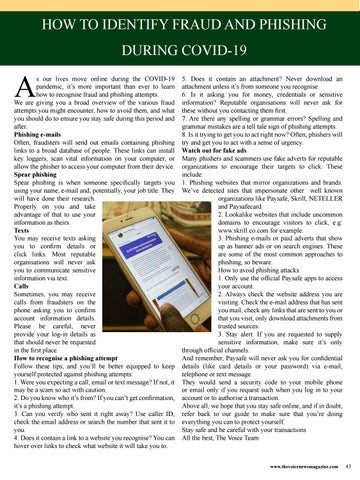HOW TO IDENTIFY FRAUD AND PHISHING DURING COVID-19
A
s our lives move online during the COVID-19 pandemic, it’s more important than ever to learn how to recognise fraud and phishing attempts. We are giving you a broad overview of the various fraud attempts you might encounter, how to avoid them, and what you should do to ensure you stay safe during this period and after. Phishing e-mails Often, fraudsters will send out emails containing phishing links to a broad database of people. These links can install key loggers, scan vital information on your computer, or allow the phisher to access your computer from their device. Spear phishing Spear phishing is when someone specifically targets you using your name, e-mail and, potentially, your job title. They will have done their research. Properly on you and take advantage of that to use your information as theirs. Texts You may receive texts asking you to confirm details or click links. Most reputable organisations will never ask you to communicate sensitive information via text. Calls Sometimes, you may receive calls from fraudsters on the phone asking you to confirm account information details. Please be careful, never provide your log-in details as that should never be requested in the first place. How to recognise a phishing attempt Follow these tips, and you’ll be better equipped to keep yourself protected against phishing attempts: 1. Were you expecting a call, email or text message? If not, it may be a scam so act with caution. 2. Do you know who it’s from? If you can’t get confirmation, it’s a phishing attempt. 3. Can you verify who sent it right away? Use caller ID, check the email address or search the number that sent it to you. 4. Does it contain a link to a website you recognise? You can hover over links to check what website it will take you to.
5. Does it contain an attachment? Never download an attachment unless it’s from someone you recognise. 6. Is it asking you for money, credentials or sensitive information? Reputable organisations will never ask for these without you contacting them first. 7. Are there any spelling or grammar errors? Spelling and grammar mistakes are a tell tale sign of phishing attempts. 8. Is it trying to get you to act right now? Often, phishers will try and get you to act with a sense of urgency. Watch out for fake ads Many phishers and scammers use fake adverts for reputable organizations to encourage their targets to click. These include: 1. Phishing websites that mirror organizations and brands. We’ve detected sites that impersonate other well known organizations like Paysafe, Skrill, NETELLER and Paysafecard. 2. Lookalike websites that include uncommon domains to encourage visitors to click, e.g: www.skrill.co.com for example. 3. Phishing e-mails or paid adverts that show up as banner ads or on search engines. These are some of the most common approaches to phishing, so beware. How to avoid phishing attacks: 1. Only use the official Paysafe apps to access your account. 2. Always check the website address you are visiting. Check the e-mail address that has sent you mail, check any links that are sent to you or that you visit, only download attachments from trusted sources. 3. Stay alert. If you are requested to supply sensitive information, make sure it’s only through official channels. And remember, Paysafe will never ask you for confidential details (like card details or your password) via e-mail, telephone or text message. They would send a security code to your mobile phone or email only if you request such when you log in to your account or to authorise a transaction. Above all, we hope that you stay safe online, and if in doubt, refer back to our guide to make sure that you’re doing everything you can to protect yourself. Stay safe and be careful with your transactions All the best, The Voice Team
www.thevoicenewsmagazine.com
43














